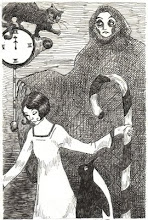
Suddenly every post is in some way inspired by Oz (which, in my defense, is so much better than that week when every post was inspired by the Holocaust). I had been thinking about my favorite Oz book (
Ozma of Oz), and about Tik-Tok the clockwork man, and decided that now was a good time to finally read the
Ann* and
Jeff VanderMeer edited
Steampunk anthology that's been sitting on my shelf for a while. Like most anthologies, it's pretty hit or miss, but happily, the hits predominate. There are three non-fiction essays included and, in my opinion, one glaring omission.
The stories that particularly impressed me were:
"The Giving Mouth" by
Ian R. MacLeod. It's beautifully written and so very, very strange. I'm not sure it strictly qualifies as Steampunk according to my understanding of the term - it's set in a fictional feudal dystopia with mechanized elements, but the writing is lovely. It reminded me a bit of some long, strange meandering fairy tales I have read (again, with mechanized elements). The only quibble I have is that the world building was a little stronger than the story telling.
"Seventy-Two Letters" by Ted Chiang was simply awesome. It's set in a slightly altered Victorian England where golems are being created and given life in factories by scientists and sculptors. It's about 50 pages long, and in this short space he manages to tell an intricately plotted story, explore the moral implications from the point of view of labor, bio-ethics, eugenics, religion and gender. The fact that the story remains exciting and it never bogs down is a tiny miracle.
"Victoria" by
Paul di Filippo is so daffy, light-hearted and well written I loved it in spite of my better instincts. I hate it when men write stories and all the women are whores because it's really the most boring default setting imaginable - and this is no exception. But - otherwise this story is such an engaging delight I'll pretty much forgive it anything.
Speaking of one's better instincts, Joe R. Lansdale's
splatterpunk Boy's Own story, "The Steam Man of the Prairie and the Dark Rider Get Down: A Dime Novel" is completely and totally disgusting. It's full of violence, rape and assorted over the top mayhem - and I couldn't put it down. Sue me.
The Neal Stephenson and Michael Chabon entries are also totally worth reading, but that's to be expected.

Now for the glaring omission. This might have more to do with my personal interests, but I think leaving Oz out of the Steampunk equation is madness. Aside from Tik-Tok the clockwork man, L. Frank Baum's Oz books are filled with mechanical inventions. Both
Professor H.M. Wogglebug, T.E. (the "H.M." is short for "highly magnified", "T.E." is short for "thoroughly educated") and the Wizard come up with lots of exciting mechanical inventions and devices. The sensibility in Baum's books is so remarkably modern, so specifically American, they really do deserve to be mentioned in the same essays as the Steam Man from the much more poorly written and rarely read boy's stories. Again, it may be my own prejudices at play, but is that the issue? That the Steam Man is from literature aimed at boys and Oz is so happily inclusive of girls? I don't think the omission was intentional, but I really do think it worth noting.
They weren't among my favorites, but several female writers were represented in the collection. I love the VanderMeers' sensibility - I also strongly recommend their completely engaging
The Thackery T. Lambshead Pocket Guide To Eccentric and Discredited Diseases. They are both on the faculty at
Clarion this year. I've been thinking about applying for a while but have never gotten myself together in time -I'm still a little traumatized from missing the Neil Gaiman/Kelly Link year.

* Interestingly, in the interview with Ann VanderMeer I linked to, when asked how she became interested in genre, she responded thusly:
Hard to say. I’ve always been an avid reader and lean more towards horror, fantasy and science fiction in my reading tastes. My dad had a collection of all the early L. Frank Baum books from his childhood. And I’m not just talking about The Wizard of Oz, I am talking about the entire series. These were the editions from the 1940’s and they were absolutely beautiful.
One more thing I'd like to note: how hilarious is Tik-Tok's patent infringement notice?








































